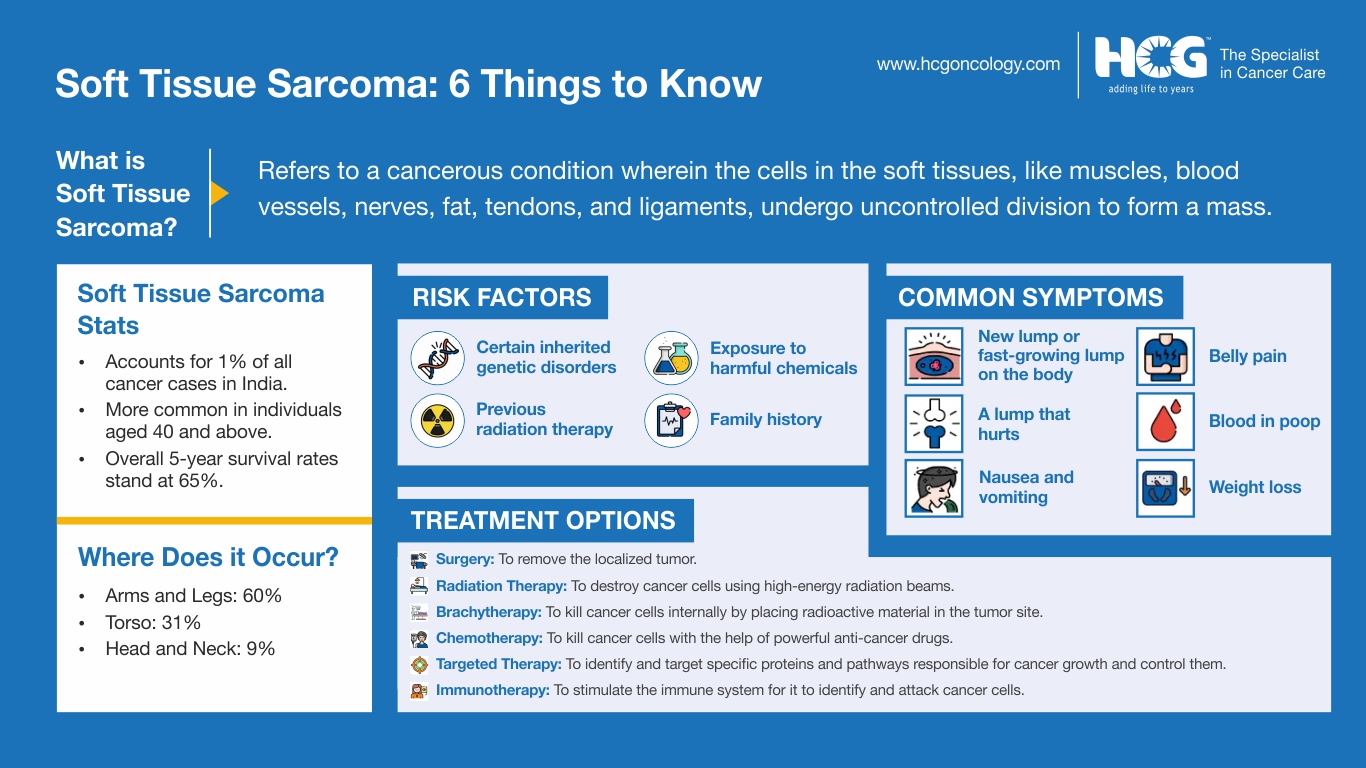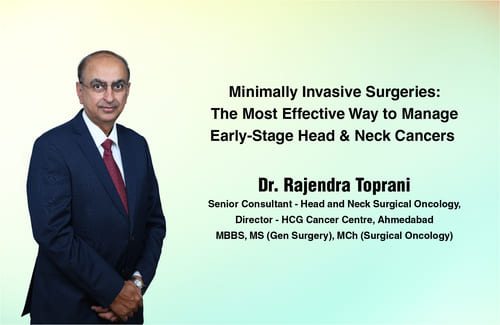
20 Nov, 2025
Feel free to reach out to us.

20 Nov, 2025
.jpg)
This article is medically reviewed by Dr. Mayur Kamnani, Consultant - Orthopaedic Oncosurgery, HCG Aastha Cancer Centre, Ahmedabad.
Soft tissues in the human body support, connect, and surround other organs and body parts. Cartilage, blood vessels, muscles, lymph vessels, tendons, fibrous tissues, tissues surrounding joints, and nerves are the different soft tissues present in the body.
When the cells of these soft tissues divide uncontrollably, it leads to the development of soft tissue sarcoma (STS).
Although STS can occur in any soft tissues in the body, the abdomen, legs, arms, and retroperitoneum are the most commonly affected tissues.
STS is rare and occurs in about one to four of every 100,000 individuals worldwide. While it can occur in any age group, it is more common in individuals aged 40 and above.
This type of soft tissue sarcoma in adults affects the arms, legs, or chest. It also has the potential to spread rapidly to other body parts.
This sarcoma type forms in the fat cells and mostly affects the soft tissues of the abdomen and limb muscles, but it may also occur in other body parts.
Smooth muscles are present in the bladder, abdomen, intestine, uterus, and blood vessels. STS that affects smooth muscles is known as leiomyosarcoma.
This soft tissue sarcoma type is rare and aggressive, and it most commonly occurs in the head and neck regions, genitourinary tract, and extremities (arms and legs).
This sarcoma type usually starts in the bone or in the soft tissues that surround the bone. The most common sites for Ewing sarcoma include the long bones (like thigh bones), pelvic bones, and ribs. Ewing sarcoma in soft tissue is very rare.
It occurs in the inner lining of the lymph and blood vessels. Although angiosarcoma may occur anywhere in the body, the most common sites are the spleen, breasts, liver, and skin.
This type of STS occurs in the dermis and may extend to the subcutaneous fat. In rare cases, fascia and the muscles may also be involved. The tumor is generally slow-growing.
This soft tissue sarcoma type is slow-growing, and it usually affects the hands, arms, fingers, feet, and legs. In most cases, there is a small, firm lump or growth under the skin known as a nodule.
This STS type usually occurs in the connective tissues of the legs and arms. It starts as a slow-growing lump under the skin. Patients often do not experience any sarcoma symptoms in the initial stages.
This type of sarcoma generally affects older adults and occurs in the connective tissue that supports other organs. The most common site of solitary fibrous tumors is the lining of the lungs, known as the pleura.
Spindle cell neoplasm consists of spindle-shaped cells and mostly occurs in the legs, arms, and pelvic bones. This condition could either be benign or malignant.
Synovial sarcoma is also known as malignant synovioma and occurs in the leg, arm, or foot. Synovial sarcoma is also found near the joints, such as the ankle and wrist.
There are different stages of soft tissue sarcoma depending on the extent of the disease’s spread.
This stage of soft tissue sarcoma is divided into stages 1A and 1B. Stage 1A is characterized by a tumor that is less than 5 cm, while a stage 1B tumor is greater than 5 cm. The tumor is of low grade or unknown grade in both sub-stages.
In stage 2, the tumor size is less than 5 cm, and the tumor is either mid- or high-grade.
Stage 3 STS is divided into stages 3A and 3B. Stage 3A is characterized by a tumor larger than 5 cm but not greater than 10 cm, while a stage 3B tumor is greater than 10 cm. The tumor could be of mid-grade or high-grade.
Stage 4 soft tissue sarcoma is the most advanced condition. In this stage, the disease would have spread to distant organs, irrespective of the tumor size and tumor grade.

Soft tissue sarcoma symptoms usually depend on the organ that is affected. The most commonly observed soft tissue sarcoma symptoms include:
In some cases, patients may experience less common symptoms, including:
Various risk factors have been identified as the potential causes of soft tissue sarcoma, and they include:
Certain inherited genetic conditions or syndromes could be the possible causes of soft tissue sarcomas.
This condition occurs due to a defective TP53 gene. Individuals with Li-Fraumeni syndrome have a higher risk of developing malignancies like brain tumors, leukemia, breast cancer, and sarcoma.
It is also known as von Recklinghausen disease and is caused by mutations in the NF1 and NF2 genes. Approximately 5% of people with neurofibromatosis develop sarcomas.
Gardner syndrome is caused by a defective APC gene. This condition is found to increase STS risk.
It refers to the cancer of the eye in children and is caused by a mutation in the RB1 gene. People with retinoblastoma are at increased risk of developing sarcomas.
This condition is caused by the defective RECQL2 gene. People with Werner syndrome are at increased risk for developing certain cancers, including soft tissue sarcoma.
People exposed to certain chemicals for a significant period are at increased risk of soft tissue sarcoma. The chemicals that increase the risk of soft tissue sarcoma include arsenic, herbicides, and dioxin.
Although general exposure to radiation accounts for less than 5% of sarcomas, exposure to radiation therapy for treating other cancers increases the risk of developing sarcomas. After radiation therapy, if sarcoma recurs, it is often at the site of radiation exposure (lymph nodes or breasts). The average time gap between radiation therapy and sarcoma development is 8–10 years.
When a patient presents with the symptoms of STS, the doctor may perform a comprehensive physical examination to determine the presence of a lump or other causes of symptoms.
Additionally, the doctor may also discuss the patient’s medical history, any prior exposure to radiation therapy, the presence of any genetic disorder, and the family history.
Once the doctor suspects the presence of a malignant lump, the patient is asked to undergo imaging testing.
An X-ray for soft tissue sarcoma is usually the first test ordered after the lump is detected. A chest x-ray may also be performed to test if the sarcoma cancer has spread to the lungs.
A CT scan is recommended if the doctor suspects the presence of soft tissue sarcoma in the chest, abdomen, and back of the abdomen.
This imaging test is also conducted to detect if sarcoma cancer has spread to the liver, lungs, or other organs.
MRI provides more detailed images compared to CT scans while evaluating sarcomas of the legs and arms. It detects the size and extent of sarcomas.
The doctor usually recommends an MRI scan in case the X-ray scan shows an abnormal growth.
A PET scan uses radioactive sugar, which is injected into the blood and used for the diagnosis of soft tissue sarcoma. The tumor cells are fast-growing cells and thus take up radioactive sugar, which is then detected by a scanner.
PET scans help in determining the spread of sarcoma cancer to other body parts. It may also be combined with a CT scan (PET/CT).
Ultrasound for soft tissue sarcoma uses sound waves to develop images of the target organ for the diagnosis of soft tissue sarcoma.
The test is usually conducted to determine the characteristics of the tumor, whether the tumor is solid or fluid-filled.
If the doctor is suspicious of sarcoma growth, he may advise the patients to undergo a biopsy. A biopsy is often a confirmatory diagnosis of soft tissue sarcoma that involves obtaining a sample of abnormal tissues and sending it to the laboratory for further evaluation. A soft tissue mass biopsy can also be done through a core needle biopsy or an incisional biopsy.
A core needle biopsy involves obtaining a sample of abnormal tissue using a long, hollow needle.
When the sample of the abnormal tissue cannot be withdrawn through needle biopsy, the doctor makes a small incision to remove the lump or abnormal tissue.
Soft tissue sarcoma treatment demands a personalized approach, wherein specialists consider several factors, including the type of soft tissue sarcoma, its stage and grade, the patient’s age and health status, and lastly their preferences. The different soft tissue sarcoma treatment options available include:
Certain factors impact soft tissue sarcoma treatment planning and outcomes, and they are listed below:
Fast-growing tumors require more aggressive treatment compared to slow-growing tumors.
Tumors diagnosed at a later stage require a more complex and aggressive treatment regimen for better health outcomes.
If the location of the tumor is such that it cannot be completely removed through soft tissue sarcoma surgery, the oncologists may recommend a multimodal treatment approach involving chemotherapy, radiation therapy, and other treatments.
As cancer treatment results in significant side effects, the age of the patients plays an important role in choosing the optimal treatment for soft tissue sarcoma.
Individuals should book an appointment with an oncologist if they experience the following:
Soft tissue sarcoma occurs in the connective tissues, such as cartilage, muscles, blood vessels, lymph vessels, and nerves. These are rare types of tumors. Different soft tissue sarcoma symptoms include the presence of a lump, swelling, bone or joint pain, and weight loss. Diagnosis of soft tissue sarcoma happens through physical examination, imaging tests, and biopsies. Various soft tissue sarcoma treatment options include surgery, chemotherapy, radiation therapy, immunotherapy, and targeted therapy.
.jpg)
Author Bio : Dr. Mayur M. Kamani
Consultant - Orthopaedic Oncosurgery
MBBS, MS (Orthopaedics)
Dr. Mayur M. Kamani is a musculoskeletal oncologist with expertise in the management of pediatric and adult bone and soft tissue tumors, as well as metastatic bone diseases. He can be consulted at HCG Aastha Cancer Centre, a leading cancer hospital in Ahmedabad. He has completed fellowship training in musculoskeletal oncology and is experienced in limb salvage surgeries, sclerotherapy, pelvic resection, and soft tissue sarcoma resection. Dr. Mayur adopts a patient-centric approach, utilizing the latest cutting-edge technologies and techniques to provide personalized care and the best available treatment options.
Appointment Link: Book an Appointment with Dr. Mayur M. Kamani.
